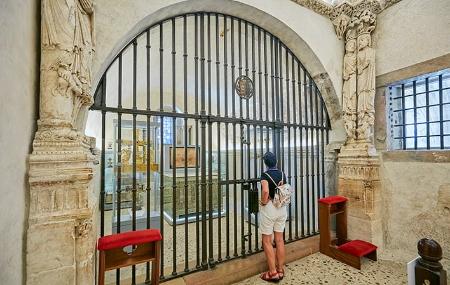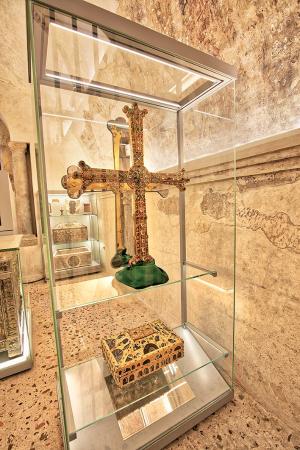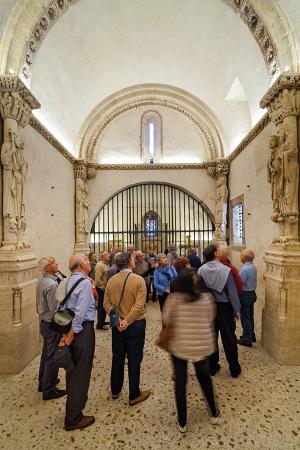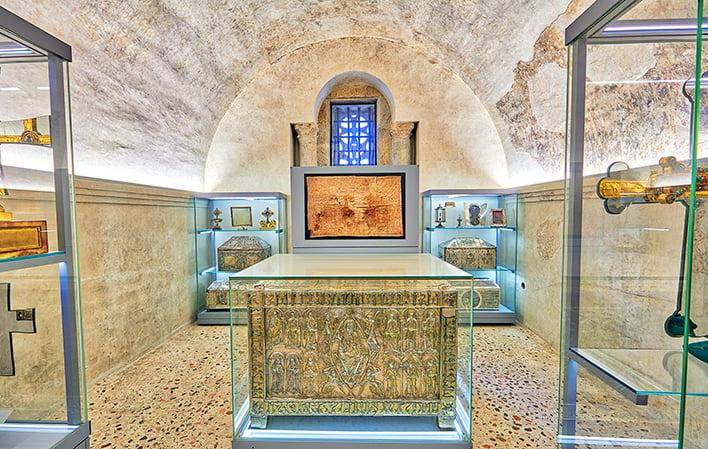
Holy Chamber
- Title Oviedo Asturias Centre
- Address Address: Pza. de Alfonso II (interior de la Catedral) ■ 33003 - Oviedo/Uviéu
- Phone Phone: 985 219 642
- Email Email: reservas@catedraldeoviedo.com
- Site Site: https://catedraldeoviedo.com
Integrated into Oviedo Cathedral, the Cámara Santa is a space that is more than emblematic of the religious, historical and cultural tradition of our country. We are talking about one of the most important reliquaries in Christianity, which also forms part of the monumental and artistic inventory of the Asturian Pre-Romanesque period. It was declared a World Heritage Site in 1998 and since the Middle Ages it has attracted a continuous pilgrimage to the city of Oviedo/Uviéu, mainly linked to the Jubilee of the Holy Cross and the devotion to the Holy Shroud.
Historical significance of the Holy Chamber
Its role is central to the Christian tradition, preserving untold treasures since the early Middle Ages: relics of the Roman crucifixions and Christ's own sweat, jewellery from ancient empires, vestiges of the crusades, all-powerful crosses from battles and reconquests...

When was the Holy Chamber built?
According to the latest archaeological studies, it was built during the reign of Alfonso III (866-910) to be an episcopal chapel and the tomb of martyrs. Soon after, it was also entrusted with the mission of protecting the relics. Its design, two superimposed naves, came from the Roman world. On the lower floor: the narrow crypt of the martyr Saint Leocadia, with a presbytery and altar at the back, and three tombs with well-carved tombstones. Above: the chapel of St Michael, where the relics are kept. This is a larger space, covered with a barrel vault and reinforced by large arches supported by the figures of the apostles (the apostolate of the Holy Chamber is considered one of the greatest works of this period).
Throughout its history, the Holy Chamber has undergone the alterations of each period, but nothing like the one it suffered during the Revolution of 1934, when a powerful charge of dynamite almost completely destroyed it. "They blew up the Holy Chamber!" the people of Oviedo shouted in the streets. Then came the hard work of clearing the rubble, the classification of all the remains and a meticulous reconstruction.

World Heritage
In 1998 it was declared a UNESCO World Heritage Site. And it was not only its relics that were the object of this title, but also the chamber itself for its architectural and historical importance. A"palatine chapel" capable of reconciling worship with the vainglory of monarchs who proclaimed themselves "humble servants of Christ". They had to zealously protect the divine treasures entrusted to them, and for this purpose the Holy Chamber was attached to the Tower of San Miguel, a defensive watchtower belonging to the old church of San Salvador - on which the Cathedral of Oviedo stands today.
The Holy Chamber and the Cathedral of Oviedo: "Sancta Ovetensis".
Arriving from the Holy Land, the relics began to be venerated from then on and throughout the Middle Ages. The Cathedral of El Salvador itself would receive the nickname of"Sancta Ovetensis" for housing this chamber, receiving an enormous flow of pilgrims who wanted to witness the existence of the sacred pieces.
Oviedo and the Way of Saint James
Oviedo Cathedral and the Holy Chamber were the starting point of the Primitive Way, the oldest known route to Santiago de Compostela. They were also traditionally an obligatory stop on the Northern or Coastal Way. "He who goes to Santiago and not to the Saviour, visits the servant and not the Lord". With this popular saying, pilgrims were urged to make a detour to visit the Oviedo cathedral before continuing on to Santiago.
This pilgrimage reached such heights that the Chapter itself formally requested the papacy to celebrate a jubilee -something that was granted by the Holy See in 1438.
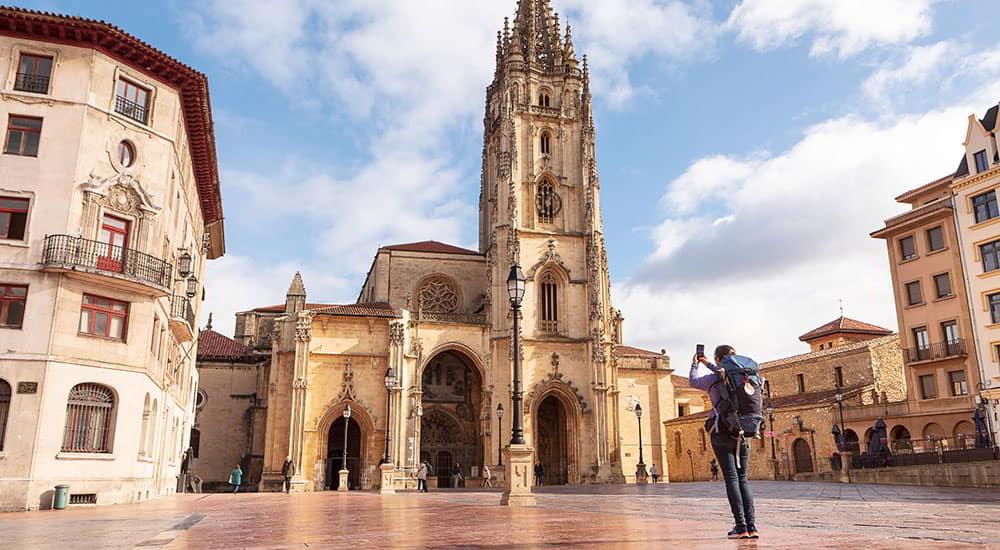
Jubilee of the Holy Cross
The papal bull granted plenary indulgence to those who went to the Cathedral to celebrate the Exaltation of the Holy Cross. The pardonanza, as it is also known, has been celebrated since then between 14 and 21 September, days on which it is possible to gain this indulgence if one goes to confession and shows repentance, receives communion at the Eucharist and prays for the Pope.
Already in the Middle Ages solemn processions were organised on these days. The Holy Shroud was also shown to the faithful. This tradition is still alive today.
When can the Holy Shroud of Oviedo be seen?
The Holy Shroud remains in the Holy Chamber all year round, it is only exposed to the public three days a year: at the end of the mass on 14th September, the Day of the Exaltation of the Holy Cross; on 21st September, at the High Mass in honour of St. Matthew; and on Good Friday after the celebration of the Passion of the Lord.
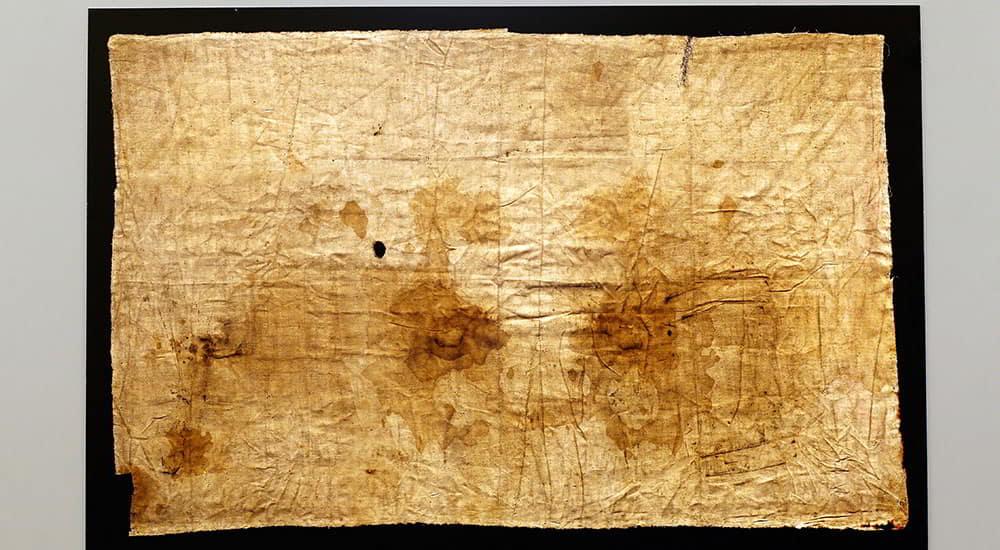
What relics does the Holy Chamber hold?
Guarded in the heart of Oviedo Cathedral, the Holy Chamber protects some of the most venerated relics of Christianity. Of particular note are the Holy Ark - which, according to tradition, arrived after a long exodus from Jerusalem -, the Victoria Cross, the Cross of the Angels and the Box of Agates, unique jewels of faith, history and medieval Asturian art.
The Holy Ark
It was sealed in 614 in the face of the imminent Persian invasion of Jerusalem, and ended up in Oviedo in the 8th century as it escaped the Muslim advances. In the 12th century, after a purifying period of fasting and prayer at the court of Alfonso VI (it was believed that a blinding light would make it impossible to see what it contained), the ark was finally opened.
It contained so many relics that, according to the chroniclers, only God could count them. But in reality there were "only" about three hundred, among them the Holy Shroud, the cloth that covered the face of Christ after his death (the second most important relic in Europe after the Holy Shroud), as well as fragments of the Holy Cross, a piece of bread from the Last Supper, thorns from the crown of the crucified, hair of the Virgin Mary, bones of prophets and even manna with which Yahweh fed the Jewish people in the Exodus.

The Agate Box
It was made of gold in the 8th century, with thin layers of agate and other precious stones. On the base is a commemorative inscription that ends with the warning 'Whoever dares to take these gifts from us, let him be killed by the divine lightning'.

The Victoria Cross
A Latin cross, one metre high, with an oak core and covered in gold, was made by Alfonso III in the year 908. Alfonso III had it covered with precious stones in the year 908. According to tradition, it was carried by Don Pelayo in the battle of Covadonga, and for this reason it has become the undisputed emblem of the Principality of Asturias.
The Angels' Cross
The most fervent chronicles claim that it was made by celestial spirits in the guise of goldsmiths. It is covered with small gold threads, precious stones and a large agate cameo. Some say that some of these jewels may have belonged to the treasure of the Emperor Augustus.

